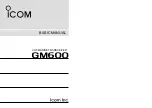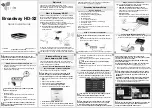
34
OPERATION
Operation
It is always a good idea to check the readout for
the channel data to make certain that it matches
the audio logo information shown on the back of
a DVD package. In some cases you will see indi-
cation for “2/0/0” even when the disc contains a
full 5.1, or 3/2/.1 signal. When this happens,
check the audio output settings for your DVD
player or the audio menu selections for the spe-
cific disc being played to make certain that the
player is sending the correct signal to the AVR.
PCM Playback Indications
PCM is the abbreviation for Pulse Code
Modulation, which is the type of digital signal
used for standard CD playback, and other non-
Dolby Digital and non-DTS digital sources such
as Mini-Disc. When a PCM signal is detected, the
Main Information Display
Ò
will briefly
show a message with the letters PCM, in addi-
tion to a readout of the sampling frequency of
the digital signal.
Connections may be made to either the rear-
panel
Optical
or
Coaxial Inputs
NR
or the
front-panel
Digital Inputs
*Ó
.
To listen to a PCM digital source, first select the
input for the desired source (e.g., CD). Next press
the
Digital Select Button
Û
G
and then
use the
⁄
/
¤
Buttons
D
on the remote, or
the
‹
/
›
Selector Buttons
7
on the front
panel, until the desired choice appears in the
Upper Display Line
Ò
.
During PCM playback, you may select any
Surround mode except Dolby Digital or DTS, as
shown in the table below. Note that for conven-
ience, we have included the modes available for
analog sources (including the tuner) in the chart
on the bottom of this page.
In most cases this will be
4 8 KHZ
, though in
the case of specially mastered, high-resolution
audio discs you will see a
9 6 KHZ
indication.
The
PCM 4 8 KHZ
indication will also appear
when modes or inputs are changed for analog
sources. In those cases the system is telling you
the sampling frequency used internally at the
output of the analog-to-digital converters that
change the incoming signal from a VCR, tape
deck, the tuner, or other ana-log source to digi-
tal.
Speaker/Channel Indicators
In addition to the
Bitstream Indicators
, the
AVR features a set of unique channel-input
indicators that tell you how many channels of
digital information are being received and/or
whether the digital signal is interrupted.
(See Figure).
These indicators are the L/C/R/LFE/SL/SR letters
that are inside the center boxes of the
Speaker/Channel Input Indicators
$
in the
front panel
Main Information Display
Ò
.
When a standard analog stereo or matrix
surround signal is in use, only the “L” and “R”
indicators will light, as analog signals have only
left and right channels.
Digital signals, however, may have one, two, five
separate channels, depending on the program
material, the method of transmission and the
way in which it was encoded. When a digital
signal is playing, the letters in these indicators
will light in response to the specific signal being
received. It is important to note that although
Dolby Digital, for example, is referred to as a
“5.1” system, not all Dolby Digital DVDs or audio
tracks selected on DVD or other Dolby Digital
programs are encoded for 5.1.
Thus, it is sometimes normal for a DVD with a
Dolby Digital soundtrack to trigger only the “L”
and “R” indicators.
Incoming Signal
Available Surround Modes
Analog (2-channel), Tuner, PCM 44.1kHz or 48kHz
Dolby Pro Logic II (Movie, Music or Game), Dolby Pro Logic, Dolby 3 Stereo, Dolby Virtual Speaker
Reference (2 or 3 Speaker), Dolby Virtual Speaker Wide (2, 3, 4 or 5 Speaker), DTS Neo:6 (3-channel
Cinema, 5-channel Cinema or Music), Logic 7 (5-channel Cinema, Music or Enhance), Hall 1
(5-channel), Hall 2 (5-channel), Theater (5-channel), Surround Off**, 5-Channel Stereo,
DSP Surround Off
PCM 96kHz
Dolby Pro Logic II (Movie or Music), Dolby Pro Logic, Logic 7 (5-channel Cinema, Music or Enhance),
DSP Surround Off
** The Surround Off mode is only available for ananlog sources or the tuner, and requires that the tone controls be removed from the circuitry for “flat” response. Otherwise, the DSP Surround Off
mode may be selected when a two-channel presentation is desired.
For incoming DTS signals, the following modes are available:
Incoming Bitstream
Available Surround Modes
DTS 1/0/.0, 1/0/.1, 2/0/.0, 2/0/.1, 3/0/.0, 3/0/.1, 3/1/.0 or 3/1/.1 DTS, DTS Stereo
DTS 2/2/.0, 2/2/.1, 3/2/.0 or 3/2/.1
DTS, DTS Stereo
DTS 96/24
DTS 96/24, DTS Stereo
DTS-ES Matrix
DTS, DTS Stereo
DTS-ES Discrete
DTS, DTS Stereo
30935_AVR145_ENG 01/12/06 9:53 Side 34
















































